Prosecco is popular, no doubt about it, and especially this year when it seems there’s little to sparkle about.
But there’s so much more to Italian Sparkling wine than Prosecco!
Not that there’s anything wrong with this charmat method, inexpensive, and appealing sparkler grown in Prosecco Doc and DOCG and made from the Glera grape, but all over Italy you’ll find sparkling wine made in the traditional method (Metodo Classico) and the ancient method as well as from international and local, indigenous grapes.
Bubbles in Italian sparkling wine range from frizzante to seafoam to rambunctious and brief to long lasting. Some wines, like those made in the charmat method, are intended to be enjoyed immediately as are some made in the traditional method, while others can be laid down for as long as you can imagine– or can wait!
While many of the Italian Sparkling wine houses you’ll find in the US are huge commercial operations, others, like those imported by Verovino, are small family businesses.
In this introduction to Italian Sparkling Wines Beyond Prosecco, we will focus on wines made from the latter, small family businesses doing regenerative agriculture and using sustanainble, organic, and biodnamic practices. Join me next week for Prosecco DOC and DOCG!
Below we taste and pair three white sparkling wines from three areas of northern Italy plus three red ones from Lambrusco made from the Salamino grape.
Following a morning ZOOM with VeroVinoGusto owner and importer Sheila Donahue with Bugno Martino in Lambrusco, Sheila joined Sue and I for a wine pairing dinner with those three red sparkling and three white ones.
2017 Azienda Agricola Tomisa “Ciparisso” Frizzante Grechetto Gentile IGP
ABV 13.5%; SRP $22
Azienda Agricola Tomisa uses cement to retain floral fruit, because cement breathes like wood; this is made using the autoclave method.
According to US importer Sheila Donahue, this is a wine you can age. When we tasted it, we were sure it was an orange wine — a white wine with extended skin contact. But we were wrong. The Grechetto Gentile grape has a thick skin full of tannins and flavor and it doesn’t take much contact to impart a lot of character. Grown in various regions including Umbria and Bologna in Emilia-Romagna where it used to be known as Pignoletto. But they figured out it was the same grapes so they decided to use Pignoletto for the region and Grechetto Gentile for the grape.
We were surprised to learn from Sheila that there are “loads” of frizzante in Italy, but they are very hard to find in the States. What’s great about them is that the effervescence cuts rich cuisine.
This is a super food friendly wine — no surprise because it’s from Bologna, the food capital of Italy, says Sheila. This is the go to wine in Bologna. The wine takes its name from a huge cypress tree on the property. Sheila told us a myth about how the sky’s best friend was a deer and he mistakenly killed the deer and his penance was to become a deer. Something is definitely lost in translation! The wine gets its name from the cypress tree.
Color: The color of honey, it looks like an orange wine, a white wine made with extended skin contact.
Nose: Orange and orange pith, orange oil, lemon grass. Intense and lively.
Palate: Light fizz on the palate brings texture to the intense complex flavors of orange and Chinese Five Spice. Acidity and texture abound but are in balance. This a great wine pair really well with food from bright salads to rich pastries. Consider this for your next brunch but don’t add orange juice — this is not a base for mimosa!
Pairing: A traditional pairing is a tortellini in a broth, or in cream –not served in red sauce like we commonly do in the US. Oysters bring out nice richness, but it was not the best pair; I would rather go with muscles or clams. Very nice with the sausage puffs. Fantastic with our caprese salad topped with fried prosciutto.
I love this wine. So interesting. So complex. Fascinating.
This producer also does a Barbera being imported by Sheila’s company that we’ll have to sample in May when we host the Italian Food Wine Travel group with that as a theme.
2013 Borgo La Gallinaccia Franciacorta
ABV 12.5%
SRP $45
Chardonnay and Pinot Noir
Winemaker and vineyard owner Matteo Gazziero grew up in Franciacorta but he didn’t like the Franciacortas he was finding, so he decided to make his own from his organic grapes..
Sheila emailed me to say that she “finally had the chance to speak with Matteo Gazziero this week to refresh myself about his winery and specifically his 2013 Franciacorta Brut and his winery La Gallinaccia http://www.borgolagallinaccia.it/en. The name refers to the hamlet where the winery is. Matteo is from the Franciacorta area. It was initially his father who had the initial passion of Franciacorta wines and started the farm/vineyard in 1998 and winery in 2005, initially making reds then sparkling wines, and Matteo took over the winery from him. He has a little less than 2 hectares of vineyards.” In total she says they make 15K bottles using 100% organic grapes. Because his wines have a lot of acidity, they age 10+ years. He also re-ferments them on the lees for longer time than Franciacorta DOCG requires. For the Brut, 18 months is the minimum but he does at least 48 months bottle fermentation on the lees. “Due to longer aging on the lees, his wines are more complex than a typical Franciacorta,” says Sheila. “When I was in Italy I wondered why everyone wasn’t drinking Franciacorta, such a great flavor.”
This is a WOW wine for me. I love Franciacorta and this one is exceptional.
Learn more at http://www.borgolagallinaccia.it/en/franciacorta-vintage-brut-docg. Steel fermented, min 48 mos maturation on lees, and disgorged August 2018. On the website there’s a new label and he gave a name to this wine, Farneticante, which means delirious.
We love Franciacorta! If you are going to splurge and spend $40 or $50 for a bottle of wine, you get so much more from your money when you go with Franciacorta.
Color Pale straw, delicate bubbles,
Nose: Yeast, brioche, almond crossant, very classic Franciacorta, white stone fruit, green apple, nice fruit considering the age of the wine. At times sparkling wine does not have that much nose, this one does.
Palate: Nice foam across the palate, nice acidity, lemon, a bit chalky, alluvial soil from the Dolomites, limestone soils, so delicious. Fresh fruity, an bit of toast, nice minerals, a little bit of everything. To me it tastes like a grower maker champagne as opposed to a big house champagne.
Pairing: The kumomoto oyster really paired well with the wine. great with our sausage puffs as well
Cantine Briamara “Bere Nice” Erbaluce di Caluso DOCG
ABV 12.5%
According to Sheila, the name “erbaluce” comes from a term meaning “dawn’s light” and bere means to drink.They have been making wines since 1931, and the main grape they specialize in is urbalucce. It is a very versatile grape, says Sheila. This wine is made in the traditional method with 36 months on the lees
Color: Golden, lemon gold.
Nose: Brioche, Almond crossant
Palate: Chalky texture, not much in the way of fruit, much more about the minerals.
Pairing: Oysters brought out a great deal of bubbles in the wine. A very interesting chemical reaction between the two. Lovely melon creaminess when the two are together. Great pairing with our garlic basil sausage puffs.
Three Wines from Bugno Martino
This is their third vintage which she says is a “project of love first of all. Guiseppe and I fell in love 20 years ago so this is a love story. We had our jobs in different branches (of wine). Guiseppe is deeply connected to sustainability for the environment. We studied a lot about wines particularly organic and natural wine making.”
It just so happened that Giovanni, Guiseppe’s father is the owner of the family farm and when he retired, “we discovered the old family farm was perfect for a winery to be natural and organic philososphy.” Fifteen years ago they planted their first vineyard. Today 9 hectares of Lambrusco is planted in their estate of 17 hectares.
For many years, Lambrusco was an industrially produced, simple, sparkling wine, basically tasting like a sweet soda with alcohol. Often wines were pasturized, and the time consuming classical method was swapped for charmat.
Today there’s an artisanal movement in Emilia-Romagna with fewer producers. These artisanal makers pay greater attention to the landscape and in the cellar only using natural fermentation and the wines are really different. in the past artisan Lambrusco winemakers recognized the potential of these brands and discovered if we respect our vines this is why if we go back to
The 17 lambrusco grapes can be blended to make artisan wine and represent the future of Lambrusco: “we are really proud the artisan Lambrusco is increasing day by day.” As they are really different from conventional wines, “we are very happy that they are really appreciated. Our mission is to return to Lambrusco its identity.”
The alluvial soil once was the Po river bed: “our soil ranges from clay to less compact soils.”
This region is hot, humid, often foggy, making it a challenging environment to grow grapes naturally but they “do everything natural for the land, returning the organic material back to the soil.” They even have a meteorological sensor that analyzes the humidity of the climate in the vineyard so tells them how much copper and sulphur to use.
2019 – Bugno Martino – Rosso Matil de – 11% alcohol – $21
Open this wine, drink it up, and enjoy that day! Serve as an appertivo, on its own, but mainly as a wine that you would have with food. It’s 80% salamina and 20% ancellotta.
Color: Dark dense I saw ruby with a garnet rim, Sue saw plum, tiny bubbles cling to the glass at the rim.
Nose: Dried cherries, herbs, fennel,
Palate: Cherry cough drop, cherry, herbs.
Pairing: Very lovely with pumpkin soup. Great with sausage puffs. Loved the herbs in the sausage, and the garlic. Salty savory crunchy bites go so well with the wine. Nice with our salad: the fizz of the wine went so well with the crunch and the fattiness in the salami crumbles.
2019 Bugno Martino Ciamballa
ABV 12%
The winery is organic, going in the direction of biodynamics, and made in the Charmat method. This wine, Ciamballa, is named after her daughter, an affectionate name for her referring to her larger belly when she was younger.
Color: Ruby garnet
Nose: Cherry and herbs, earth,
Palate: Delicate fizz, clean, fresh fruit and herbs, earth comes across on the palate as well as the nose.
Pairing: The soup was wonderful with the wine. This pairing brought out the sweetness in both the wine and the soup. The sausage puffs brings out the cherry in the wine, and the sausage puffs bring out the herbs in the sausage.
When the wine is made in smaller batch in an artisanal way, the bubbles will last longer. I simply put a spoon in the neck of the bottle, put it in the fridge and the bubbles lasted for days!!
Color: Ruby purple rim, persistant bubbles
Nose: You can smell the yeastiness and the lees, cherries, I got more minerals, Sue felt there was more fruit, a combination of cherry and black licorice.
Palate: Dry and refreshing, tannins and chalk, the fruit is in the essence of the wine. Cherry croissant, but not sweet at all. Tart and fresh.
Pairing: Fantastic with the pumpkin soup which can be found in the region which has a tradition of serving squash in their dishes. Earth meets earth. The saltiness from the fried prosciutto works so well together. One of our great pairings. Great Thanksgiving wine. The sausage puffs brought out a nice fruit in the wine. The wine is complex and goes so nicely with food.


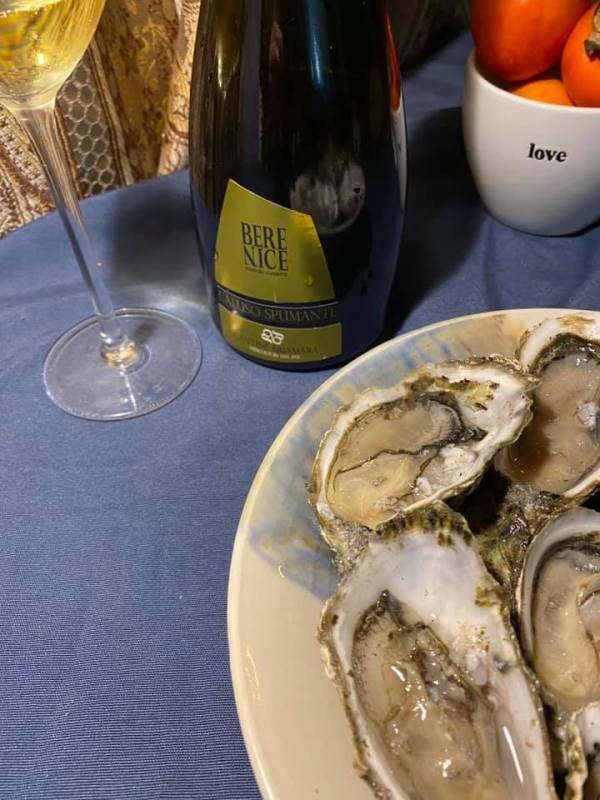
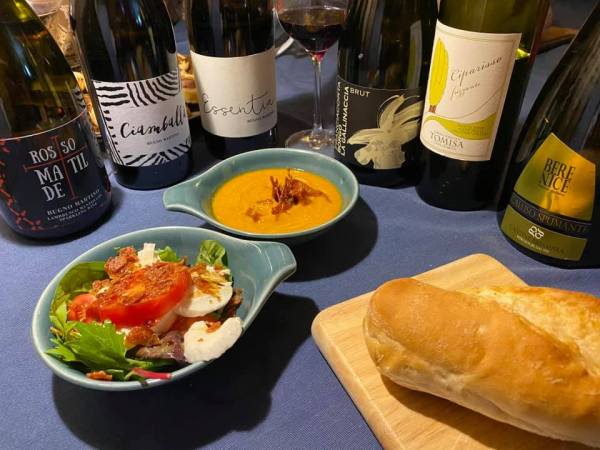
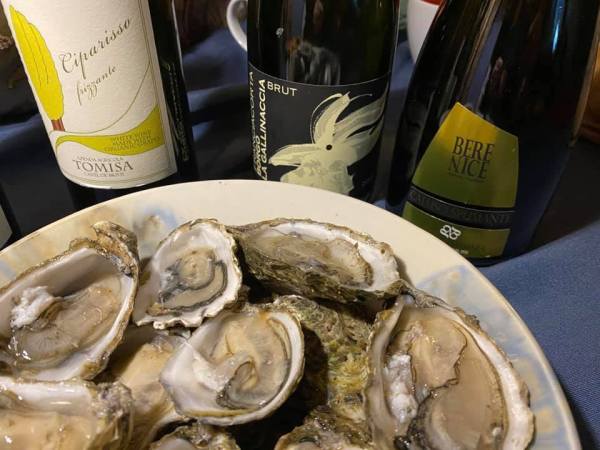
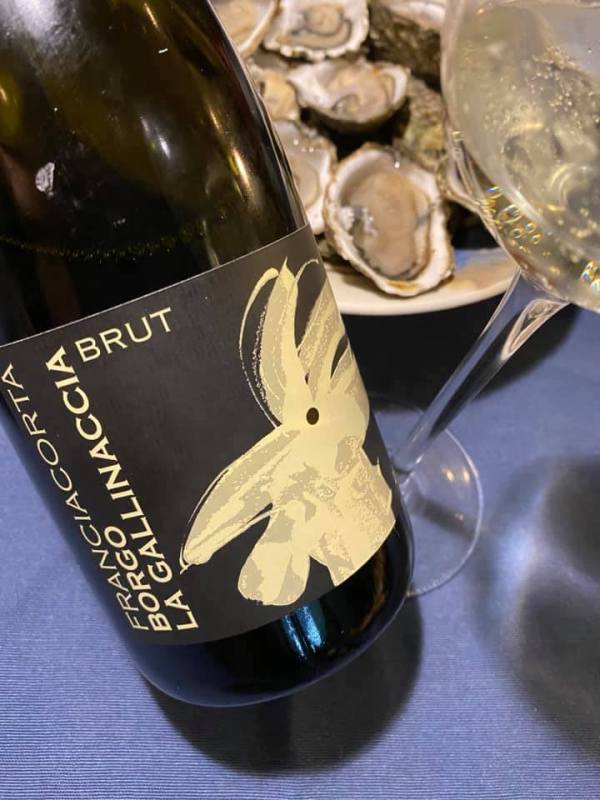
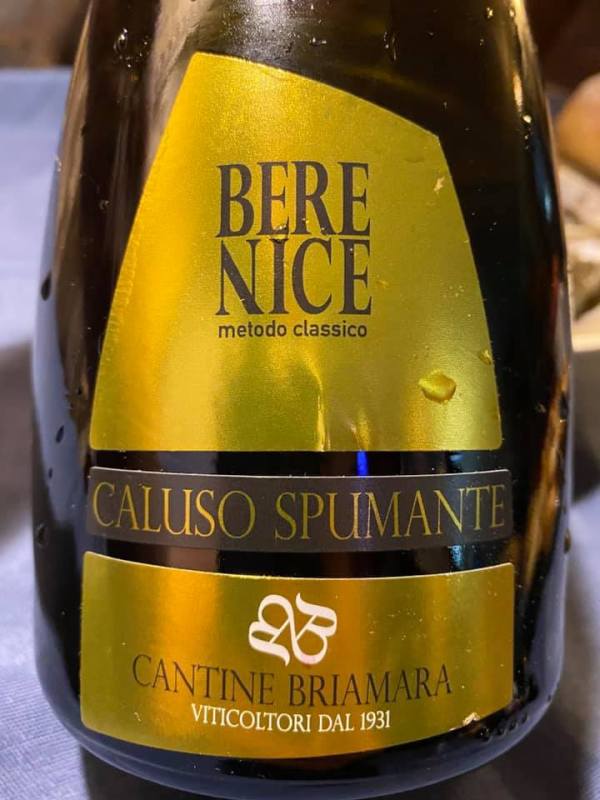
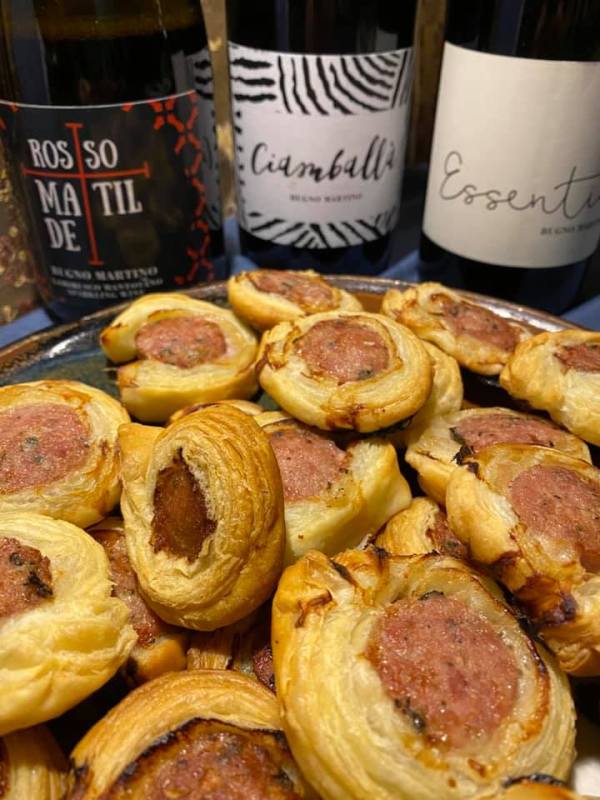
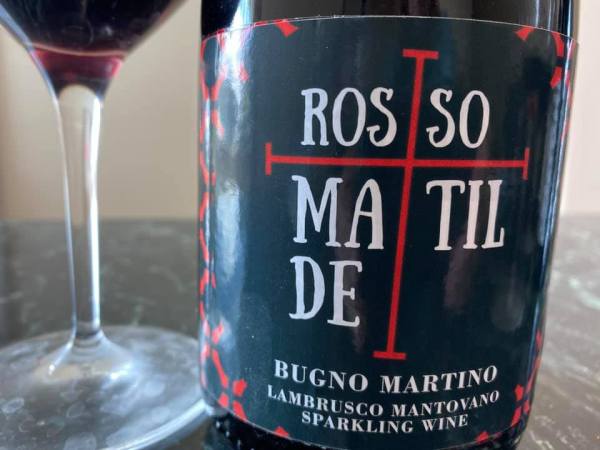

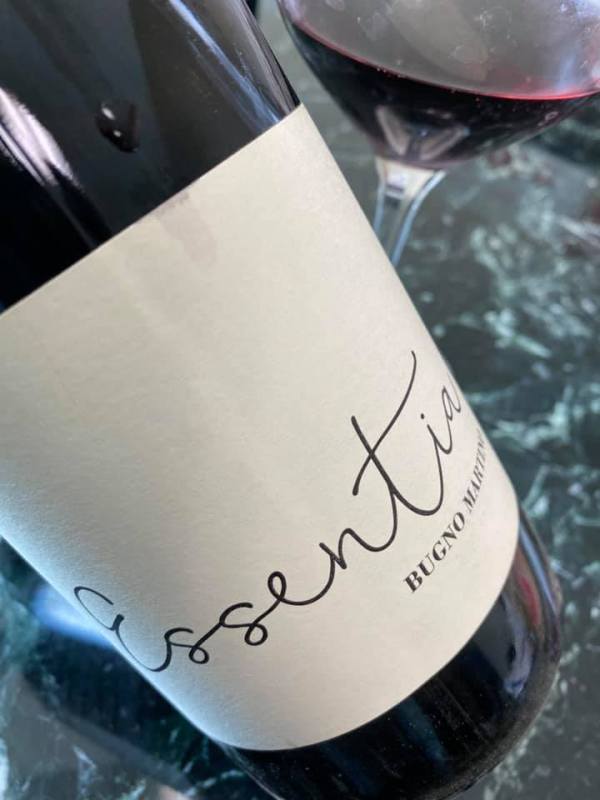

I’m a fan of Erbaluce! And Sheila is right! (hi Sheila!), it’s extremely versatile! Still, sparkling, passito… This grape can do it all! And then there’s Franciocorta and the lambrusco family… You had me at wine! LOL!
LikeLiked by 1 person
I just hope more people discover the wealth and breadth of Italian sparkling wine! I’m looking forward to learning more about Erbaluce for sure!
LikeLiked by 1 person
When I was in Italy several years I made the mistake of asking for “Prosecco” when I was in Southern Italy. I was quickly corrected and told it is called “Spumante”. Ever since then, I’ve paid close attention to the place of origin for Italian bubbly. What an interesting and great line up Gwen!
LikeLiked by 1 person
Thanks and thanks for sharing your story! It can be intimidating for sure for Americans not familiar with the wines, the grapes’ nd the regions of Italy — I had to check with Sheila about my title to make sure I had it right!
LikeLike
Such an interesting line up, you’ve certainly struck gold meeting Sheila. Nice pairing notes… I never turn down oysters! I’m going to see if any of these wines can be sent to France, eyeing all especially the Erbaluce. Holiday cheers Gwendolyn!
LikeLiked by 1 person
Yes, meeting Sheila AND that she’s based so close to my home has been so amazing! We appreciate the wines she’s importing so much!
LikeLike
Wow, Gwendolyn, you’ve got a sparkling Italian wine to suit everyone’s taste. Love your description of this range: “from frizzante to seafoam to rambunctious.” Happy holidays!
LikeLiked by 1 person
Yes, we do– thanks to Verovinogusto importing them into the US! So fun!
LikeLike
What a glorious selection of sparkling wines! So many beautiful wines in such a great variety of styles! Every time I get comfortable with what I know about Italian wines, I find that there are more and more varieties and styles to discover!
LikeLiked by 1 person
That is so true Robin! There are so many interesting Italian whites that it could get intimidating!
LikeLiked by 1 person